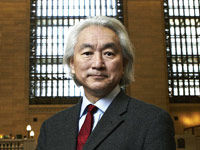Staying Fit
The future is here.
In labs across the world, prototypes for driverless cars, smart bombs that attack cancer and mind-controlled computers are passing their test drives as you read this. Now physicist Michio Kaku brings us his vision of our next 100 years in his latest book, Physics of the Future, based on more than 300 interviews he conducted with the world's greatest scientists and innovators. (Read an excerpt from Physics of the Future.)
He spoke with the AARP Bulletin about a few of the innovations that will revolutionize — and extend — our lives.


Q. You say we will find evidence of extraterrestrial life in the next 50 years. Why?
A. One in 200 stars has habitable Earth-like planets surrounding it — in the galaxy, half a billion stars have Earth-like planets going around them — that's huge, half a billion. So when we look at the night sky, it makes sense that someone is looking back at us.
Q. You also say that we'll be able to listen in on their conversations.


AARP Membership— $12 for your first year when you sign up for Automatic Renewal
Get instant access to members-only products and hundreds of discounts, a free second membership, and a subscription to AARP the Magazine.
A. Yes, we may be able to receive signals that have been sent our way. But communication will be one-sided because other habitable planets are so far away, the signals will take many decades and centuries to reach them, and many decades and centuries to come back. Earth has only had radiotechnology for 50 years, so they will not hear us yet.
Q. What else will we discover in outer space?
A. In the next 50 years we'll find evidence of a parallel universe. I believe we exist in a multiverse of universes.
Q. How?
A. There is a new satellite called LISA that will pick up radiation from the instant of the big bang. Many people think that our universe is a bubble of some sort. The theory is that when such a bubble bumps into another bubble, a big bang event occurs, creating another universe. So LISA may give us the first hard proof of the existence of other universes.
Q. Let's talk about space travel for us. Will the cost go down?
A. Space tourism is coming pretty fast now. But it's still expensive, $200,000 for a ticket. It will go down. If you want to go to the space station, it costs $20 million. If you just want to go on Space Ship 2, up and down, it's about $200,000. Space travel will be for the wealthy for a long time. Until we get the space elevator. Our grandkids may have that, later in the century.
Q. Space elevator?
A. You'll go into an elevator, hit the up button, and go into outer space. The key thing is nano-fibers, which will extend like Jack and the Beanstalk up to the heavens. Centrifugal force will hold the stalk in place.
Q. Getting back to Earth, you also write that soon technology will enable us to have more computer power in our bathrooms than in today's modern hospital. Explain that.
A. Day-to-day interactions with an animated doctor can be done via your computer screen on the bathroom wall. Ninety-nine percent of aches and pains can be helped by a robot doctor that will always be on call, will never complain or refuse a house call, and will be dirt cheap because it's a software program. Now, more delicate things like surgery and cancer treatment will need to be done at a hospital.
Q. We'll also have handheld MRI machines to analyze our bodies at home?
A. Yes, the tricorder medical scanners from Star Trek will be a reality very soon. The world's smallest MRI machine is the size of a PC, but the original was the size of an office, it was huge. Soon they will bring it down to the size of a cellphone, called a tricorder. We'll be able to scan right inside your body.
Q. How will cancer care change?
A. Both cancer treatment and cancer detection will be unrecognizable from today. Researchers have developed something called DNA chips that can detect proteins emitted from maybe 100 cancer cells in a colony years before a tumor forms. Hospitals are already testing them. In the future, your toilet may have DNA chips that will tell you that in 10 or 20 years, you will have a tumor. The word "tumor" will disappear from the English language.
Q. Because we'll treat cancer cells before they grow into a mass?
A. Exactly. For example, we used to think that pancreatic cancer was fast-growing, that in two to three years you would die. Now we know that's not true; we realize now that it takes 20 years for pancreatic cancer to grow, and only in the last two years can you feel it.
Q. How will doctors treat these early cancers?
A. We're now experimenting with what are called nanoparticles. This is huge. These are molecules that can hone in on cancer cells and either deliver a poison or actually shake up a cancer cell and destroy it. There are several different groups now experimenting with them. In one study they were up to 90 percent effective against cancer cells.
Q. And they leave healthy cells untouched?

































































More From AARP
One Hundred Names for Love
A literary couple untangles a medical conundrum.